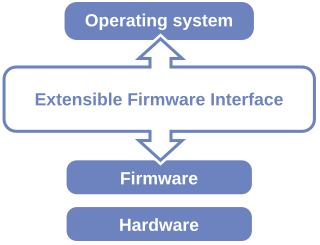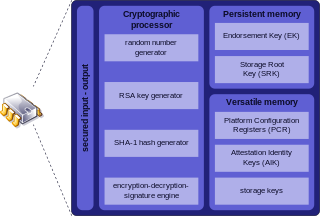
In computing, BIOS is firmware used to perform hardware initialization during the booting process, and to provide runtime services for operating systems and programs. The BIOS firmware comes pre-installed on a personal computer's system board, and it is the first software to run when powered on. The name originates from the Basic Input/Output System used in the CP/M operating system in 1975. The BIOS originally proprietary to the IBM PC has been reverse engineered by some companies looking to create compatible systems. The interface of that original system serves as a de facto standard.

PowerPC is a reduced instruction set computer (RISC) instruction set architecture (ISA) created by the 1991 Apple–IBM–Motorola alliance, known as AIM. PowerPC, as an evolving instruction set, has since 2006 been named Power ISA, while the old name lives on as a trademark for some implementations of Power Architecture–based processors.
The PowerOpen Environment (POE), created in 1991 from the AIM alliance, is an open standard for running a Unix-based operating system on the PowerPC computer architecture.
Common Hardware Reference Platform (CHRP) is a standard system architecture for PowerPC-based computer systems published jointly by IBM and Apple in 1995. Like its predecessor PReP, it was conceptualized as a design to allow various operating systems to run on an industry standard hardware platform, and specified the use of Open Firmware and RTAS for machine abstraction purposes. Unlike PReP, CHRP incorporated elements of the Power Macintosh architecture and was intended to support the classic Mac OS and NetWare, in addition to the four operating systems that had been ported to PReP at the time.
PowerPC Reference Platform (PReP) was a standard system architecture for PowerPC-based computer systems developed at the same time as the PowerPC processor architecture. Published by IBM in 1994, it allowed hardware vendors to build a machine that could run various operating systems, including Windows NT, OS/2, Solaris, Taligent and AIX.

The Unified Extensible Firmware Interface (UEFI) is a publicly available specification that defines a software interface between an operating system and platform firmware. UEFI replaces the legacy Basic Input/Output System (BIOS) firmware interface originally present in all IBM PC-compatible personal computers, with most UEFI firmware implementations providing support for legacy BIOS services. UEFI can support remote diagnostics and repair of computers, even with no operating system installed.
A hypervisor is a kind of emulator; it is computer software, firmware or hardware that creates and runs virtual machines. A computer on which a hypervisor runs one or more virtual machines is called a host machine, and each virtual machine is called a guest machine. The hypervisor presents the guest operating systems with a virtual operating platform and manages the execution of the guest operating systems. Multiple instances of a variety of operating systems may share the virtualized hardware resources: for example, Linux, Windows, and macOS instances can all run on a single physical x86 machine. This contrasts with operating-system–level virtualization, where all instances must share a single kernel, though the guest operating systems can differ in user space, such as different Linux distributions with the same kernel.
The Intelligent Platform Management Interface (IPMI) is a set of computer interface specifications for an autonomous computer subsystem that provides management and monitoring capabilities independently of the host system's CPU, firmware and operating system. IPMI defines a set of interfaces used by system administrators for out-of-band management of computer systems and monitoring of their operation. For example, IPMI provides a way to manage a computer that may be powered off or otherwise unresponsive by using a network connection to the hardware rather than to an operating system or login shell. Another use case may be installing a custom operating system remotely. Without IPMI, installing a custom operating system may require an administrator to be physically present near the computer, insert a DVD or a USB flash drive containing the OS installer and complete the installation process using a monitor and a keyboard. Using IPMI, an administrator can mount an ISO image, simulate an installer DVD, and perform the installation remotely.

In a computer, the Advanced Configuration and Power Interface (ACPI) provides an open standard that operating systems can use to discover and configure computer hardware components, to perform power management e.g. putting unused hardware components to sleep, to perform auto configuration e.g. Plug and Play and hot swapping, and to perform status monitoring. First released in December 1996, ACPI aims to replace Advanced Power Management (APM), the MultiProcessor Specification, the PCI BIOS specification, and the Plug and Play BIOS (PnP) Specification. ACPI brings the power management under the control of the operating system, as opposed to the previous BIOS-centric system that relied on platform-specific firmware to determine power management and configuration policies. The specification is central to the Operating System-directed configuration and Power Management (OSPM) system. ACPI defines a hardware abstraction interface between the system firmware, the computer hardware components, and the operating systems.

Trusted Platform Module is an international standard for a secure cryptoprocessor, a dedicated microcontroller designed to secure hardware through integrated cryptographic keys. The term can also refer to a chip conforming to the standard.
Open Platform Management Architecture (OPMA) is an open, royalty free standard for connecting a modular, platform hardware management subsystem to a computer motherboard. Platform hardware management generally refers to the remote monitoring of platform hardware variables such as fan speed, voltages, CPU and enclosure temperatures along with a wide range of other sensors. It also implies the ability to remotely control the power state of the platform and to reset the system back into an operational state should it "hang". A significant advantage of OPMA over previous generation management subsystem attachment methods is that OPMA does not consume a PCI socket. OPMA cards are also smaller and lower cost than their PCI predecessors.
Microprocessors belonging to the PowerPC/Power ISA architecture family have been used in numerous applications.
Power.org was an organization whose purpose was to develop, enable, and promote Power Architecture technology. Its objective was to establish open standards, guidelines, best practices and certifications for Power Architecture, and to drive adoption of the platform.

The Linux Foundation (LF) is a non-profit technology consortium founded in 2000 as a merger between Open Source Development Labs and the Free Standards Group to standardize Linux, support its growth, and promote its commercial adoption. It also hosts and promotes the collaborative development of open source software projects.

Linaro is an engineering organization that works on free and open-source software such as the Linux kernel, the GNU Compiler Collection (GCC), power management, graphics and multimedia interfaces for the ARM family of instruction sets and implementations thereof as well as for the Heterogeneous System Architecture (HSA). The company provides a collaborative engineering forum for companies to share engineering resource and funding to solve common problems on ARM software.
A trusted execution environment (TEE) is a secure area of a main processor. It guarantees code and data loaded inside to be protected with respect to confidentiality and integrity. A TEE as an isolated execution environment provides security features such as isolated execution, integrity of applications executing with the TEE, along with confidentiality of their assets. In general terms, the TEE offers an execution space that provides a higher level of security for trusted applications running on the device than a rich operating system (OS) and more functionality than a 'secure element' (SE).
In computing, a devicetree is a data structure describing the hardware components of a particular computer so that the operating system's kernel can use and manage those components, including the CPU or CPUs, the memory, the buses and the peripherals.
The OpenPOWER Foundation is a collaboration around Power ISA-based products initiated by IBM and announced as the "OpenPOWER Consortium" on August 6, 2013. IBM is opening up technology surrounding their Power Architecture offerings, such as processor specifications, firmware and software with a liberal license, and will be using a collaborative development model with their partners.

The Power ISA is an instruction set architecture (ISA) currently developed by the OpenPOWER Foundation, led by IBM. It was originally developed by IBM and then now-defunct Power.org industry group. Power ISA is an evolution of the PowerPC ISA, created by the mergers of the core PowerPC ISA and the optional Book E for embedded applications. The merger of these two components in 2006 was led by Power.org founders IBM and Freescale Semiconductor. The ISA is divided into several categories and every component is defined as a part of a category; each category resides within a certain Book. Processors implement a set of these categories. Different classes of processors are required to implement certain categories, for example a server class processor includes the categories Base, Server, Floating-Point, 64-Bit, etc. All processors implement the Base category.
The Redfish standard is a suite of specifications that deliver an industry standard protocol providing a RESTful interface for the management of servers, storage, networking, and converged infrastructure.